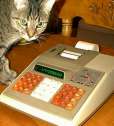Tianyan Electronics TY-82MS-3
| Datasheet legend
Ab/c:
Fractions calculation
AC: Alternating current BaseN: Number base calculations Card: Magnetic card storage Cmem: Continuous memory Cond: Conditional execution Const: Scientific constants Cplx: Complex number arithmetic DC: Direct current Eqlib: Equation library Exp: Exponential/log functions Fin: Financial functions Grph: Graphing capability Hyp: Hyperbolic functions Ind: Indirect addressing Intg: Numerical integration Jump: Unconditional jump (GOTO) Lbl: Program labels LCD: Liquid Crystal Display LED: Light-Emitting Diode Li-ion: Li-ion rechargeable battery Lreg: Linear regression (2-var. stats) mA: Milliamperes of current Mtrx: Matrix support NiCd: Nickel-Cadmium recharg. batt. NiMH: Nickel-metal-hydrite rech. batt. Prnt: Printer RTC: Real-time clock Sdev: Standard deviation (1-var. stats) Solv: Equation solver Subr: Subroutine call capability Symb: Symbolic computing Tape: Magnetic tape storage Trig: Trigonometric functions Units: Unit conversions VAC: Volts AC VDC: Volts DC |
| ||||||||||||||||||||||||||||||||||||||||||||||||||||||||
 Look what the cat, I mean the mailman, just brought in, straight from China.
Look what the cat, I mean the mailman, just brought in, straight from China.
A bona fide programmable (abeit just barely) calculator, bearing a superficial resemblance to numerous Casio models and lookalikes, yet a unique design.
The Tianyan Electronics (never heard of this manufacturer before) TY-82MS-3 is a no-nonsense basic scientific calculator, with formula entry, which is pretty much the standard these days.
But it is intelligently designed (e.g., permitting self-evident shortcuts, such as writing 2pi instead of 2*pi) and it does have a few non-trivial features, such as 13 digits of internal precision or the ability to do just linear but also quadratic regression.
And on top of all that... look, it has a LRN key!
And yes, the key signifies exactly what it should: programmability.
Very simple programmability, mind you. The LRN key simply allows the calculator to remember the most recently entered formula for later replay using the LET key. But the formula is stored in memory where it is retained even after the AC key is pressed or the calculator is turned off. Therefore, though not Turing-programmable (no jumps, no conditional execution, no addressable memory) it nonetheless qualifies as a bona fide programmable calculator.
To celebrate this discovery, here is my favorite Gamma function implementation for this calculator:
X ln X - X + ln √(2π÷X)+((((X²÷1188-1÷1680)÷X²+1÷1260)÷X²-1÷360)÷X²+1÷12)÷X


